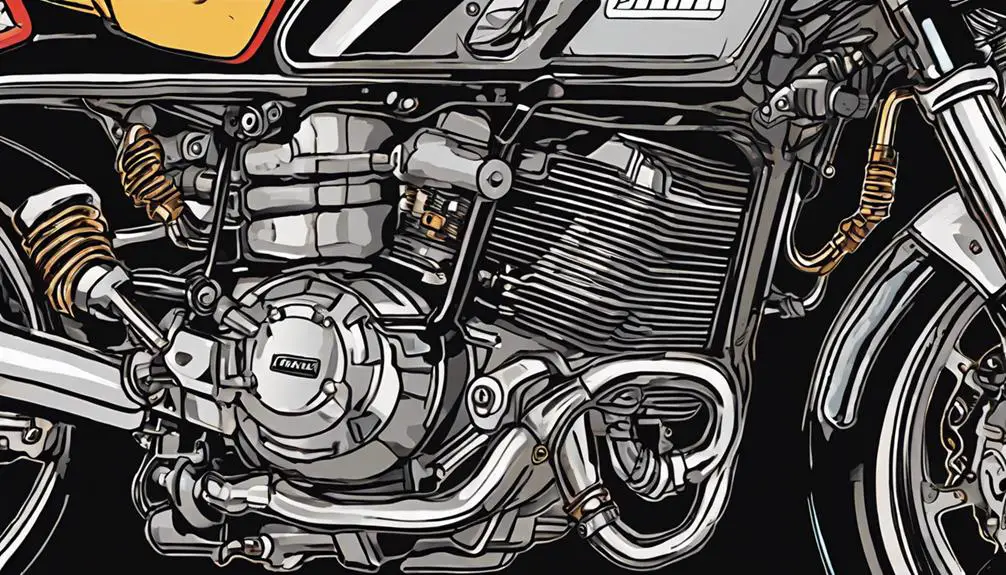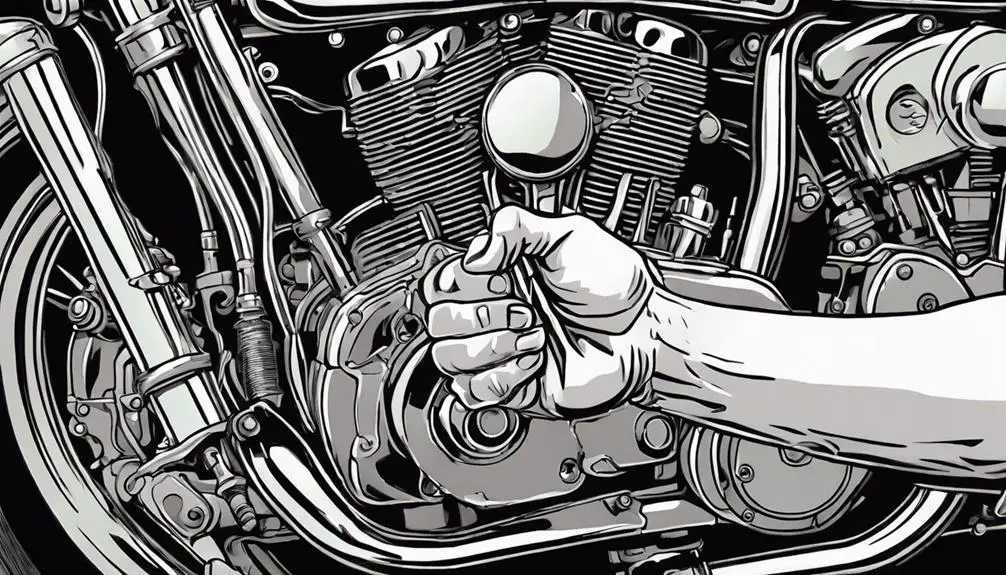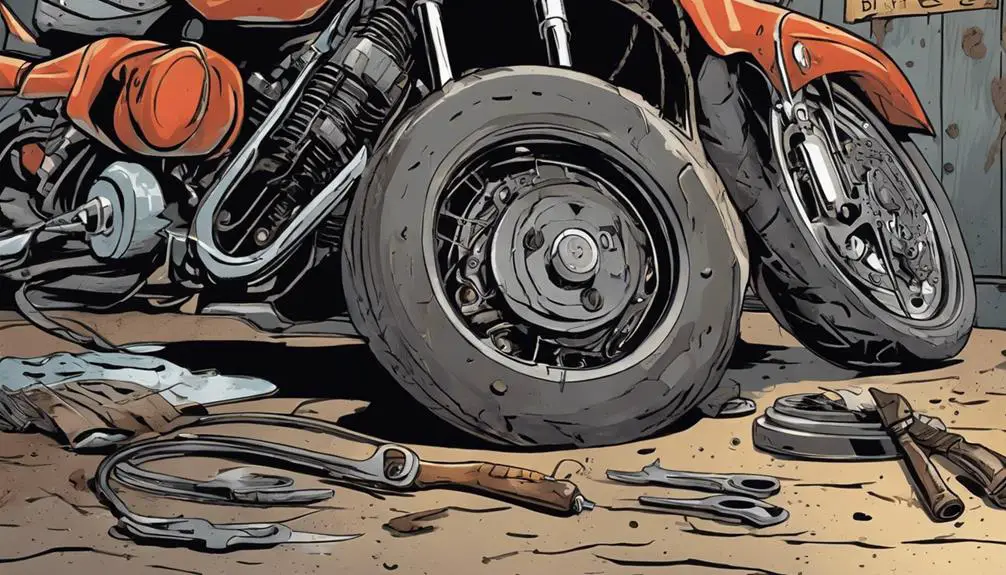You might wonder why iconic motorcycles require frequent tuning, why their electrical systems seem temperamental, and why their advanced components demand such meticulous attention. These machines, known for their engineering brilliance and performance, come with intricate challenges that can test even the most seasoned riders. From the complexities of desmodromic valves to the vulnerabilities in cooling systems, every aspect plays a role in maintaining their legendary status. Understanding these maintenance hurdles not only informs your ownership experience but also raises questions about the balance between performance and reliability.
Key Takeaways
- Iconic motorcycles often feature complex engineering, necessitating detailed maintenance to ensure peak performance and reliability.
- High-performance components, like Ducati's desmodromic valves, require meticulous adjustments and regular inspections for optimal function.
- Electrical systems in motorcycles are prone to issues like wiring vulnerabilities and battery drains, complicating maintenance efforts.
- Neglected cooling systems can lead to overheating, risking significant engine damage and highlighting the need for regular checks and maintenance.
Ducati's Engineering Complexity

Ducati motorcycles are known for their stunning performance, but their intricate engineering can pose significant maintenance challenges. If you're a proud owner, you might find yourself grappling with the complexities of their design. These machines are built with high-performance components that demand meticulous attention. You'll need to stay on top of regular maintenance to guarantee everything runs smoothly.
One of the appealing aspects of Ducati is its innovative technology, but that same technology can lead to headaches. For instance, the sophisticated valve timing systems and unique desmodromic valves require precise adjustments. If you don't have the right tools or knowledge, it can feel like trying to open a treasure chest without the key.
Additionally, the lightweight materials used in their construction, while enhancing speed, can also be sensitive to wear and tear. You must keep a close eye on everything from the chain to the brakes, making sure each part operates harmoniously.
Embracing this challenge can empower you, turning routine maintenance into an opportunity to connect with your bike on a deeper level. So, gear up, explore the complexities, and enjoy the ride—freedom awaits!
Common Electrical Issues
When you own an iconic motorcycle, electrical issues can really put a damper on your ride.
You'll likely encounter problems like wiring harness vulnerabilities, battery drain, and faulty ignition systems that can affect performance.
Understanding these common issues will help you stay ahead of maintenance challenges and keep your bike running smoothly.
Wiring Harness Vulnerabilities
The wiring harness on iconic motorcycles often faces vulnerabilities that can lead to various electrical issues, affecting performance and safety. These issues can't only disrupt your ride but also put you at risk. You might experience problems like flickering lights, sudden engine stalls, or even complete electrical failures.
Here are three common vulnerabilities to watch out for:
- Frayed Wires: Over time, exposure to heat, moisture, and vibrations can wear down the insulation, leading to shorts and failures.
- Loose Connections: Vibration can loosen connectors, causing intermittent issues that can leave you stranded on the road.
Addressing these vulnerabilities head-on will allow you to ride confidently, knowing your motorcycle's electrical system is in top shape.
Don't let wiring issues hold you back; take the time to inspect and maintain your wiring harness. By doing so, you'll guarantee your freedom on two wheels continues without interruption. After all, embracing the open road is what truly fuels your spirit.
Battery Drain Problems
Battery drain problems can sneak up on you, leaving your iconic motorcycle unable to start and forcing you to troubleshoot electrical issues. You might find yourself stranded, longing for the open road, only to be thwarted by a dead battery. These problems often arise from parasitic drains, where electrical components continue to draw power even when you've turned off the ignition.
It's essential to regularly check your battery and connections. Corroded terminals or loose wires can contribute to rapid drainage, robbing your ride of its spirit. Confirm your battery's health with regular maintenance and a good charge; a healthy battery is your ally in freedom.
If you notice trouble starting, test your battery with a voltmeter. A reading below 12.4 volts indicates it's time for a recharge or replacement. Don't let these issues chain you down.
Consider investing in a smart battery maintainer to keep your battery in peak condition during downtime. You deserve the thrill of the ride, not the frustration of a dead battery. Stay vigilant, and let nothing hold you back from the adventures that await.
Faulty Ignition Systems
A faulty ignition system can leave you frustrated and stranded, hindering your ride just when you're ready to hit the road. When your motorcycle won't start or misfires, it can feel like your freedom's been put on hold. Understanding common electrical issues can empower you to tackle these problems head-on.
Here are some typical signs of ignition system failure:
- Delayed Start: If your bike struggles to start, it might be a sign of a failing ignition coil.
- Poor Acceleration: A weak spark can lead to sluggish performance when you twist the throttle.
Addressing these issues can restore your ride and keep the open road within reach. Regular inspections and maintenance of your ignition system can help prevent these frustrating moments.
Don't let electrical problems derail your adventures; take charge and guarantee your bike's ignition system is in top shape. Embrace the freedom of the ride by staying proactive about your motorcycle's maintenance!
Maintenance of Desmodromic Valves

Maintaining desmodromic valves requires attention to detail and a solid understanding of their unique operation. Unlike standard valve systems, desmodromic setups use a mechanism that opens and closes the valves mechanically. This design eliminates the need for valve springs, which can enhance performance but demands meticulous upkeep.
You'll need to regularly check the valve clearance and adjust it as necessary. Ignoring this can lead to reduced performance and potential engine damage. The adjustment process involves specific tools, so make sure you have what you need before diving in.
It's also essential to inspect the rocker arms and the entire desmodromic system for wear and tear. These components can wear out faster than you might expect, especially if you ride hard. Keep an eye on lubrication, as proper oil flow helps maintain the integrity of these parts.
Taking the time to understand and care for your desmodromic valves not only enhances your motorcycle's performance but also liberates you from future headaches. By staying proactive, you'll experience the thrill of the open road without the burden of unexpected breakdowns. Embrace the freedom that comes with informed maintenance.
Cooling System Concerns
When it comes to your motorcycle, keeping the cooling system in check is essential.
Overheating can lead to significant engine damage, so you'll want to pay attention to radiator maintenance and coolant quality.
Ignoring these factors can result in costly repairs down the line.
Overheating Engine Issues
Overheating engine issues often arise from neglected cooling systems, leading to potentially severe damage if not addressed promptly. You don't want to be stranded on the side of the road, feeling the heat—not just from the sun but from your motorcycle's engine, too. Keeping the cooling system in check is essential for the freedom you crave on the open road.
Here are a few key areas of concern:
- Coolant Levels: Make sure your coolant is topped off and in good condition. Low levels can lead to overheating faster than you think.
- Hoses and Connections: Inspect hoses for cracks or loose connections. Even a small leak can disrupt the cooling system's efficiency.
Radiator Maintenance Necessities
A well-maintained radiator is essential for keeping your motorcycle's engine cool and running smoothly. If you want to enjoy the freedom of the open road, you need to pay attention to your radiator's condition. Regularly inspect it for any signs of leaks, corrosion, or damage. A small issue can escalate quickly, leading to overheating and potential engine failure.
Make sure the radiator fins are clean and free of debris. Dust, dirt, and bugs can obstruct airflow, reducing cooling efficiency. Use a soft brush or compressed air to clear them out.
Check the hoses connected to the radiator for any cracks or wear. These can lead to coolant leaks, which compromise your motorcycle's performance.
Don't forget to keep an eye on the radiator cap. A damaged or faulty cap can cause pressure loss, making it difficult for the cooling system to function properly. It's a simple check that can save you from bigger problems down the line.
Coolant Quality Importance
Quality coolant plays an essential role in your motorcycle's cooling system, directly impacting engine performance and longevity. Using the right coolant isn't just a recommendation; it's a necessity. Poor-quality coolant can lead to overheating, corrosion, and even engine failure. To keep your ride liberating and smooth, pay attention to the coolant you choose.
Here are three reasons why coolant quality matters:
- Thermal Efficiency: Quality coolant maintains ideal temperatures, preventing engine overheating during those exhilarating rides.
- Corrosion Protection: A good coolant contains inhibitors that prevent rust and corrosion, ensuring your engine parts remain intact and functional.
Tire and Brake Wear

Maintaining ideal tire and brake performance is essential for your safety and the longevity of your iconic motorcycle. As you ride, your tires and brakes endure a lot, and neglecting them can lead to serious issues.
Worn tires can compromise your grip on the road, increasing the risk of skidding or losing control. Regularly check your tire tread depth and pressure; both are vital for peak performance.
Brakes are your lifeline, so don't wait until you hear squealing or grinding noises to take action. Inspect your brake pads and rotors frequently. If you notice uneven wear or reduced responsiveness, it's time for replacements.
Feeling the freedom of the open road means ensuring your bike stops when you want it to.
Fuel System Troubleshooting
Troubleshooting your fuel system can save you from unexpected breakdowns and guarantee your motorcycle runs smoothly. When you feel that your ride isn't performing at its best, take a moment to inspect the fuel system. Ignoring issues can lead to a compromised experience on the open road.
Here are three key areas to check:
- Fuel Filter: A clogged filter can restrict fuel flow, causing sluggish performance. Replace it regularly for peak efficiency.
- Fuel Lines: Look for cracks, leaks, or blockages in the lines. Any signs of wear can lead to fuel loss and potential hazards.
Frequently Asked Questions
How Often Should I Service My Iconic Motorcycle?
You should service your iconic motorcycle at least every 3,000 to 5,000 miles, but always check your owner's manual for specific recommendations.
Regular maintenance keeps your ride in top shape, ensuring safety and performance.
Don't wait until something feels off; proactive care liberates you from unexpected breakdowns.
Pay attention to oil changes, tire pressure, and brake checks.
Embrace the freedom of the open road by keeping your machine running smoothly!
What Tools Are Essential for Motorcycle Maintenance?
Maintaining your motorcycle is like tending to a garden; the right tools cultivate a smooth ride.
Essential tools include a socket set for tightening bolts, a torque wrench for precise adjustments, and a multimeter for electrical checks.
Don't forget a tire pressure gauge and a chain cleaning kit!
With these tools at your side, you'll liberate your ride from potential issues and keep it purring like a well-tuned engine on the open road.
Are Aftermarket Parts Reliable for Iconic Motorcycles?
When you're considering aftermarket parts for your iconic motorcycle, reliability can vary.
Some aftermarket options offer exceptional quality and performance, while others mightn't meet the standards you expect.
It's essential to research brands and read reviews from fellow riders. You want parts that enhance your ride, not hinder it.
Trust your instincts, and don't compromise on quality—your motorcycle deserves the best to keep it running smoothly and looking great.
How Can I Improve My Motorcycle's Resale Value?
Boosting your motorcycle's resale value can feel like trying to tame a wild beast, but it's totally doable.
Start by keeping your bike in pristine condition—regular maintenance and thorough cleaning make a huge difference.
Document every service and upgrade you've done, as a solid history adds appeal.
Investing in high-quality aftermarket parts can also attract buyers.
What Should I Check Before a Long Ride?
Before you hit the road for a long ride, check your tire pressure and tread, ensuring they're in good shape.
Inspect your oil level and brakes, making sure everything's functioning properly.
Don't forget to verify your lights and signals work.
It's also wise to pack a basic toolkit and first-aid kit, just in case.
Conclusion
In the world of iconic motorcycles, each ride is like a dance between man and machine, where precision and passion intertwine.
Just as a skilled dancer must tend to their shoes, you must nurture your motorcycle to keep it performing at its best.
By addressing the complexities of engineering, electrical quirks, and maintenance routines, you guarantee your ride remains a symphony of power and grace on the open road, ready to conquer every twist and turn.